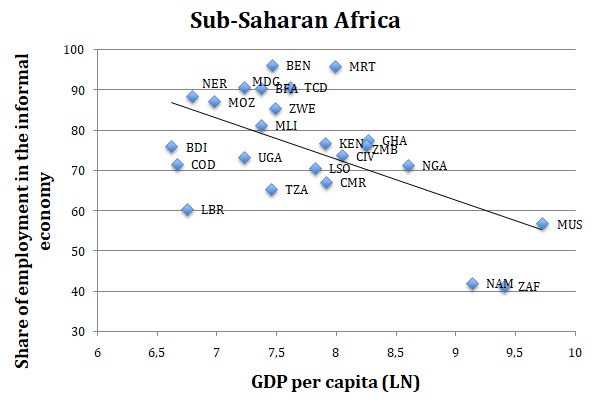1.3.2 Characteristics of the informal economy
1.3.2. Characteristics of the informal economy
As defined, employment the informal economy is a very broad concept. It is thus interesting and informative to look beyond the macro-picture to examine and understand the breadth of its components.
Table 7 below summarises a few of the main characteristics of employment in the informal economy:
Table 7: Main components and characteristics of non-agricultural employment in the informal economy by region in 2005-2010
|
REGIONS /
Countries |
% Informal Sector in Employment in the informal economy | % of informal workers outside Informal sector | % of women in the informal economy | % of self-employed in the informal economy | % of employment in industries in the informal economy |
| Middle East North Africa | 58.7% | 41.3% | 16.4% | 39.9% | 41.4% |
| Sub-Saharan Africa | 80.4% | 19.6% | 51.1% | 64.9% | 24.2% |
| Asia | 79.4% | 20.6% | 35.8% | 53.3% | 41.7% |
| Latin America | 64.6% | 35.4% | 46.5% | 52.1% | 26.8% |
| Transition | 50.5% | 49.5% | 33.2% | 32.7% | 18.0% |
Source: Charmes J. (2011). A worldwide overview of trends and characteristics of employment in the informal economy and informal sector in a gender perspective. Contribution to the update of the ILO-WIEGO Women and Men in the Informal Economy.
Employment in the informal sector accounts for more than 80% of total employment in the informal economy in sub-Saharan Africa and slightly less in Asia. This means that in these two regions, informal employment outside the informal sector absorbs only 20% of the workers in the informal economy, against nearly 50% in transition economies, 41% in Middle East North Africa and 35% in Latin America. Contrary to popular belief, it is only in sub-Saharan Africa that women outweigh men (51.1%) in the informal economy.In other regions they are fewerthan men in the informal economy (from 46.5% in Latin America to35.8% in Asia, 33.2% in transition economies and down to 16.4% in Middle East North Africa (MENA). Generally within all regions, women are relatively more numerous in informal employment outside the informal sector, as are employed as domestic workers and as home-based workers for the manufacturing industries. Self-employment represents between 1/3 (transition economies followed by MENA), half (Latin America and Asia) and 2/3 (sub-Saharan Africa) total employment in the informal economy. Lastly,industries (manufacturing as well as construction) account for less than ¼ of total employment in the informal economy in transition countries, sub-Saharan Africa and Latin America, but more than 40% in MENA countries and Asia.
Employment in the informal economy isgenerally assimilated to low productivity, low income and poverty and the fact is that it is negatively related to GDP per capita and to poverty rate, as illustrated on Charts 3 and 4 hereafter.
Chart 3: Employment in the informal economy is negatively related to GDP per capita




Sources: database used for previous tables and Human Development Report for GDP per capita (PPP).
Chart 4: Employment in the informal economy is positively related to poverty

Chart 4 shows that very high proportions of employment in the informal economy are associated with very high shares of population living under the poverty line in Madagascar and Zimbabwe for example, with moderate rate of poverty such as in Benin or Mauritania, or with low poverty rates (Indonesia, Morocco). Relatively low proportions of employment in the informal economy can be associated with low poverty rates in Brazil, Thailand or Tunisia, as well as with high poverty rates as in South Africa.
